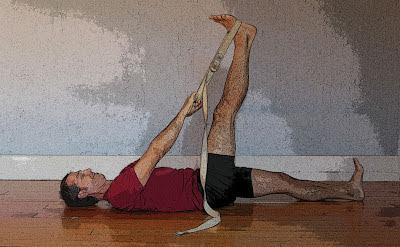 Q: I understand that having one leg shorter than another can be a source of pain in the lower back. Is that true and can yoga help?
Q: I understand that having one leg shorter than another can be a source of pain in the lower back. Is that true and can yoga help? A: The short answer is yes and yes! It just so happens I myself have a leg length discrepancy (LLD), which is just a fancy way a saying that my right leg is a bit shorter than my left. I have probably been living with this for my entire life, or at least since my leg bones stopped growing in my late teens. However, I never had any pain or dysfunction related to it until about 10 years ago when I would have short bouts of pain in my right lower back area over the right sacroiliac joint. And it was a few years after that before my amazing holistic chiropractor discovered the difference in the length of my legs on my intake physical exam.
It’s important to know that having just a slight difference in the length of your legs is fairly common, and usually does not cause symptoms nor require any special attention. And if you have one leg shorter than the other and back pain, it does not necessarily mean that LLD is the source of your pain. So you should get a good evaluation to rule out other causes of low back pain, as well as determine if you even really have one shorter leg.
That said, if the difference in the length of your legs is more than ¼ inch, it is more likely that it is contributing or causing your back pain. And if you have a ½ inch difference, your chance of having back pain due to LLD increases by a factor of 6.
The two main causes of LLD are:
- Actually having one leg shorter than the other because the leg bone itself is shorter. When you actually have one leg shorter than the other, this is called a “structural LLD,” and the approach to treatment by an orthopedist is usually the use of a heel lift in your shoe under the shorter leg to even up the legs and see if the pain resolves.
- Having a twist, torque or misalignment in the pelvic bones that makes one leg only appear to be shorter. Conditions that can cause this include scoliosis, trauma, muscle imbalances and congenital issues. This is referred to as a “functional LLD,” and the approach to treatment is quite different, with physical therapy to bring your pelvis back into even alignment.
And if you have a heel lift, you can choose to practice yoga wearing it. One of my yoga colleagues wears a thin-soled shoe on just one foot during her yoga practice. This seems to correct her imbalance and allows her to fully participate in all of her standing poses without pain, especially the symmetrical ones such as Mountain pose (Tadasana), Powerful pose (Utkatasana) and Standing Forward Bend (Uttanasana). Although I use a lift in my right shoe in everyday situations, I have not done so in my yoga practice. But being barefoot for asana practice has not triggered bouts of back pain. So each person, in consultation with your orthopedic specialist and PT, can decide on when and where a lift is helpful.
For functional LLD, working to improve pelvic evenness with your yoga practice could actually support any work you are doing with your PT to correct this. In yoga styles where alignment is a main focus of the poses, such Iyengar-style yoga, the asana practice can help restore pelvic evenness. I suggest practicing at home in front of a mirror to confirm that you are keeping your pelvis even, especially in symmetric standing poses. Also, it’s a good idea to request feedback from your teacher about your pelvic alignment in class or better yet in a private session
Although I can’t recommend specific poses to practice (each individual is different) in general, a well-balanced yoga practice that includes reclining, seated, standing, and easy inverted poses is a good starting point. And if low back pain is present, I’d recommend looking for a yoga back care class, where your teacher will likely be able to give you some special guidance.
It is not uncommon to see other painful conditions tagging along with LLD, although it is not clear if LLD contributes to their development or vice versa. The ones that yoga can help with include lower spine disc problems, scoliosis, arthritis or bursitis of the hip, flat feet, knee pain from kneecap misalignment, and sciatica due to a tight piriformis muscle. We have written about several of those conditions:
Degenerative Disk Disease and Yoga
Friday Q&A: Yoga and Bursitis
Friday Q&A: Scoliosis
Friday Q&A: Flat Feet Friday Q&A: Alignment of the Knees
I Think I Have Sciatica
—Baxter
Got a question? Email Baxter at [email protected].
Subscribe to Yoga for Healthy Aging by Email ° Follow Yoga for Healthy Aging on Facebook ° Join this site with Google Friend Connect

